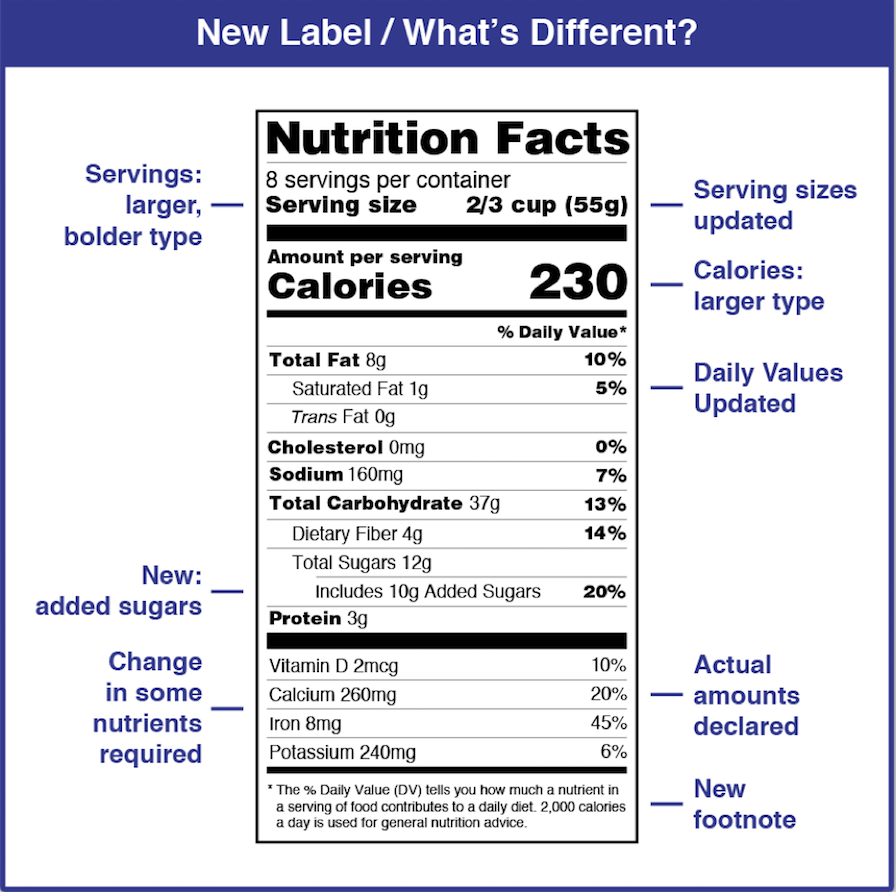Thanks to updated scientific information linking diet to chronic diseases such as heart disease and obesity, The Food and Drug Administration (FDA) began to update food labels with new recommendations and easier to read information. The change happened over the course of a few years with phase-in dates for various information and foods, but all products were required to have the new label in place by July 1, 2021.
WHAT’S DIFFERENT?
One of the key changes to the new label is that the serving size is now more prominent. On the previous label, the serving size was more obscure and it was unclear that the information on the label often applied to only a portion of the total product instead of consuming the whole package. The prominence of the serving size on the new label urges consumers to pay attention to how much they are eating.
One will also notice that the caloric content of the serving on the package is displayed in a larger font size. This simple yet impactful change draws attention to the calories per serving. The new footnote provides a general recommendation for a 2,000 calorie per day diet. This number is a broad recommendation for standard American adults per U.S. Department of Agriculture (USDA) and U.S. Department of Health and Human Services (HHS).
The label also reflects updated recommendations on nutrient quantities, additionally denoting the specific quantity of the recommended daily intake of some nutrients, besides just the percentage.
In the carbohydrates section, the new label pulls out added sugars as a separate line item, allowing consumers the opportunity to make informed decisions about additional sugars added to their foods.
WHAT DO I NEED TO PAY ATTENTION TO?
Depending on your personal health history and dietary needs, there are different parts of the label that may be of more relevance to you.
Generally speaking, looking at and understanding the calorie count is an important piece of information. Take into account the serving size and how much you plan to eat. For example, if the serving size is one bar but the package contains two and you plan to eat them both, make sure you double the calories to understand the full amount you are consuming.
In the “Total Fat” category, one important line is “trans fat.” According to the Mayo Clinic, trans fats have a doubly negative effect on heart health – reducing good cholesterol and increasing bad cholesterol. The American Heart Association (AHA) states that many trans fats are created through a manufacturing process to enhance flavors and have a long shelf life. A healthy diet will reduce or eliminate added trans fats.
Sodium is another ingredient to review carefully. The average daily recommendation for sodium is 2,300 mg per day. For those with high blood pressure or other heart disease, the daily recommended amount is 1,500 mg. According to the Food and Drug Administration (FDA), the average American consumes 3,400 mg per day. The additional salt can cause strain on blood vessels as well as contribute to bloating and weight gain.
If you have diabetes or prediabetes, pay extra close attention to the total carbohydrates listed. A target goal for many with diabetes is 45-60 grams of carbs per meal and approximately 15- 30 grams per snack.
HEALTHY EATING
Food labels appear on prepackaged food items to help consumers make informed decisions about what they are eating. A good practice is to review labels before purchasing items to ensure that the marketing on the package is aligned with the nutritional information so that you are fully aware of what you are consuming. The healthiest diet includes primarily fresh foods with limited processed items. Be a knowledgeable shopper and purchase items that help you meet your individual nutritional goals.
RELATED ARTICLES
Going for Gold: How Local Seniors Inspire Fitness at Any Age
13 Ways to Give Back This Holiday Season
Conducting an Annual Expense Review



